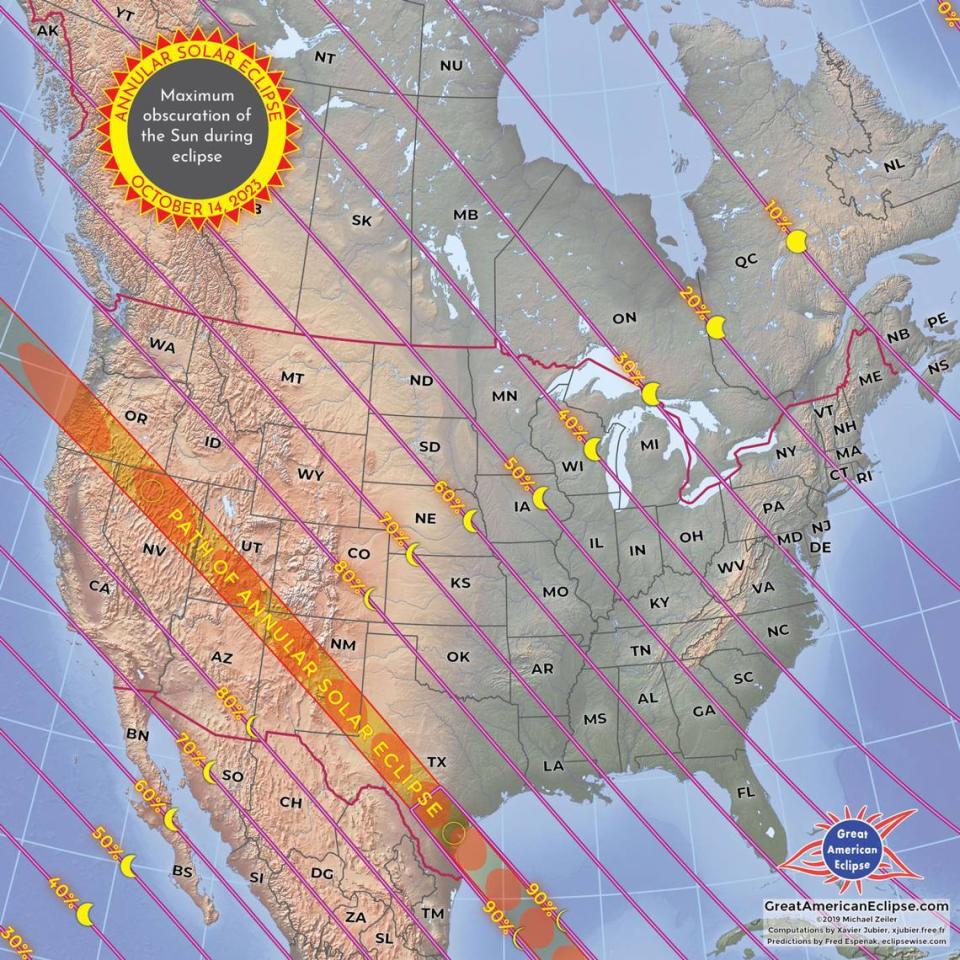Partial solar eclipse to darken Pennsylvania’s skies Saturday. Here’s when you can see it
For the first time in more than a decade, Pennsylvanians should be able to see part of a unique solar eclipse on Saturday.
The “ring of fire” annular eclipse will be most clearly visible in the western U.S., specifically in the southeastern corridor stretching from Oregon to New Mexico and Texas. However, just about all of the continental U.S. will get to see at least a partial look at the eclipse. The last annular eclipse visible in the U.S. occurred in May 2012.
If you hope to see the solar eclipse in Pennsylvania and stay safe while observing it, here’s what you need to know.
What is a solar eclipse?
Broadly speaking, a solar eclipse occurs when the moon passes between the Earth and sun, projecting a shadow back onto the Earth’s surface that can, in some cases, completely block out the sun’s rays for a brief time.
An annular eclipse, such as the one expected Saturday, occurs when the moon is farther away from the Earth in its elliptical path. The greater distance will make the moon appear smaller and, as a result, prevent it from blocking out the entire view of the sun. This phenomenon essentially makes the moon appear like a dark disk atop a larger sun-colored disk, creating a ring-like shape, NASA writes.
A partial solar eclipse occurs when the sun, moon and Earth are not precisely aligned, resulting in what appears like a dark shadow on a small part of the sun’s surface. A total solar eclipse, meanwhile, is visible from a small area on Earth and occurs when the sun, moon and Earth are in a direct line, combining to block out sunlight for a brief time.
A total solar eclipse is expected for parts of the eastern U.S. in April 2024.
During a lunar eclipse, the moon appears darkened as it passes into the Earth’s shadow. Total lunar eclipses are rare and, unlike solar eclipses, are safe to view directly.
Can I see Oct. 14’s eclipse in Pennsylvania?
Yes, but you won’t view it as strongly as someone might out west.
The moon is expected to cover just about 30% of the sun’s apparent surface when the annular eclipse is visible in Pennsylvania on Saturday, according to the National Weather Service. Weather permitting, this view should appear as a glowing crescent shape instead of a perfect ring of light.
In State College, the eclipse should be partially visible from about 11:58 a.m. to 2:33 p.m., according to Time and Date, an online world clock. Peak visibility in Centre County is slated for about 1:15 p.m., but cloudy skies and more than an inch of rain in the forecast might get in the way, according to AccuWeather.

The annular eclipse’s maximum obscuration grows significantly toward the southwest, according to forecast maps provided by Great American Eclipse Viewers in parts of Texas, Oklahoma, Colorado, Arizona and California, for example, can see the moon cover 80% or more of the sun’s apparent surface during Saturday’s eclipse.
The eclipse’s path will begin in Oregon Saturday morning before gradually sweeping through the American Southwest and exiting the U.S. through Texas. It will also be visible in parts of Mexico, Central America and South America before ending its run over the Atlantic Ocean.
How can I safely watch a solar eclipse?
It’s easy to get excited about a rare astronomical phenomenon, but you must take the proper precautions before looking up at the sky during an eclipse.
You should never look directly at the sun without appropriate protective eye gear, NASA warns. That even holds true when part of the sun’s light is blocked out during a solar eclipse.
“Except during the brief total phase of a total solar eclipse, when the moon completely blocks the sun’s bright face, it is not safe to look directly at the sun without specialized eye protection for solar viewing,” NASA writes. “Viewing any part of the bright sun through a camera lens, binoculars or a telescope without a special-purpose solar filter secured over the front of the optics will instantly cause severe eye injury.”
Glasses designed for viewing an eclipse are generally inexpensive and available online. The American Astronomical Society offers a list of reputable glasses vendors. You can even craft your own pair using materials from around the house, including aluminum foil and cardboard.
NASA recommends using a pinhole projector to view an eclipse indirectly. To create your own, poke a hole in a sheet of paper, such as an index card, and let the sunlight shine through the hole to create a shadow of the eclipse on the ground.
You might also choose to create your own projector using a cardboard box, a white sheet of paper, aluminum foil, tape and scissors, the agency says.
First, tape the white paper on the inside end of the box and, on the other end, cut out part of it and cover it with aluminum foil, leaving a small hole poked out. Cut out a section to view from on the other side of that end. Once the eclipse arrives, look through the viewpoint and face away from the sun. You should see the sunlight his the small hole in the aluminum foil and create a shadow on the white paper inside the box.
Those who hope to watch from the safety of their phone and computer screens can turn in to NASA’s live broadcast of the annular solar eclipse, schedule for 11:30 a.m. to 1:15 p.m. on the agency’s website and YouTube page. Visit youtube.com/watch?v=LlY79zjud-Q to see NASA’s broadcast of the eclipse from Kerrville, Texas, and Albuquerque, New Mexico.

